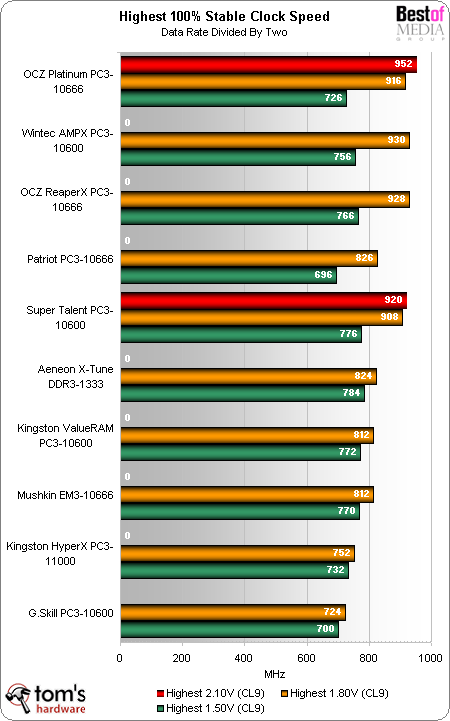DDR3-1333 Speed and Latency Shootout
Overclocking Results
Overclocking often requires increased voltage, but some modules are less tolerant of voltage increases than others. Likewise, some overclockers are more enthusiastic than others, so we picked three voltage levels to represent the majority of builders: stock (1.50 Volts), which is a reasonably safe over-voltage level (1.80 Volts); and an insane "extreme enthusiast" level (2.10 Volts). Notice that even our "reasonably safe" 1.80 volt testing increases the default voltage by 20%, yet we're fairly confident that most modules can tolerate this setting through several years of use.
To keep things fair, we set all modules to loose 9-9-9-24 timings for overclock tests. How far did we get?
OCZ Platinum DDR3-1333 easily beats competitors at 2.10 volts, trouncing even the same brand's "ReaperX" extreme-overclocking model. Wintec AMPX comes in second place overall, with the highest 1.80 volt overclock but an inability to gain from a further increase to 2.10 volts.
We were surprised that the OCZ ReaperX modules didn't overclock better at 2.10 volts than at 1.80 volts, because they're cooled so well. Yet, OCZ wasn't the only company to have its high-end parts fall behind its own lower-rated parts, as Kingston's office-grade PC3-10600 also beat its extreme-performance HyperX PC3-11000.
Now we can compare the performance of each kit's "rated timings" to that of its highest-speed CAS 9 settings. PC Mark 2005's memory bench leads the benchmark session.
Did we really need benchmarks to prove the fastest modules had the best performance? Probably not, but they certainly drive the point home. Yet, the OCZ ReaperX's 928 MHz memory clock somehow beat the 930 MHz memory clock of Wintec's AMPX, probably by using a different combination of timings other than the four we set manually.
Current page: Overclocking Results
Prev Page Test Settings: Overclocking Comparison Next Page Overclocking Results, ContinuedGet Tom's Hardware's best news and in-depth reviews, straight to your inbox.


